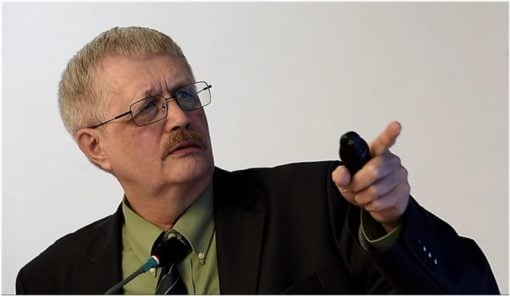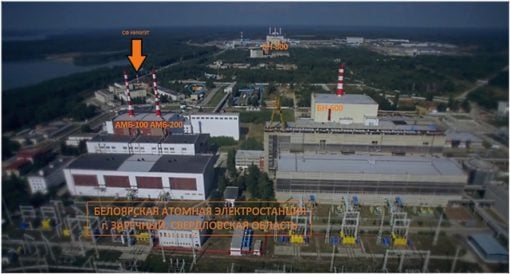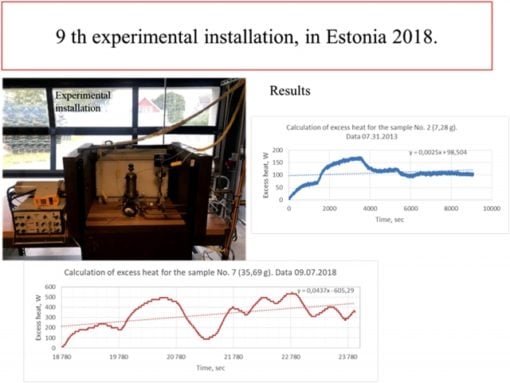Physicist and nuclear engineer Sergei Tcvetkov is the guest on the Cold Fusion Now! podcast along with Natalya Famina as translator.
Listen to Sergei Tcvetkov on the Cold Fusion Now! podcast our Podcast page.
Sergei Tcvetkov has been experimenting with unique LENR systems using titanium cathodes to generate nuclear products and excess heat since 1989. He and his team had been testing materials suitable for spaceflight when he heard the news.

“First, we had very interesting circumstances at the time of Fleischmann and Pons’ press conference”, he says. “We were working on a flight to Mars. We created a hydrogen complex of high parameters, i.e. working directly with hydrogen. It was a large complex that was designed to test various space materials. The complex is a few material science machines that worked on the rupture of metals in a hydrogen gas medium. The material of the nozzles from which the heated hydrogen should fly-out at a temperature of 2000 degrees and a pressure of up to 400 atmospheres. (Nozzles – these are the devices through which the rocket is released from a rocket engine fuel.) And that’s why we had a lot of materials that we could use for our project on cold fusion. This allowed us to assemble the existing plant within three weeks. A photo of this installation is presented in the REGNUM report.”

“Secondly, in addition, by this time we were engaged in materials of biological protection of nuclear reactors based on titanium hydride. So we were able to saturate the titanium with hydrogen. I want to draw special attention to the fact that work with hydrogen is an explosive type of work, and we had already mastered the rules of safe work with hydrogen.”
“We had a lot of specialists at our research Institute who worked at the research reactor as we did. We had specialists in radiation dosimetry, specialists in calorimetry of irradiated materials, i.e., we had a very wide set of experts and devices. Even the absence of deuterium gas couldn’t stop us. We ordered it in Siberia and it was delivered to us in three weeks.”
“From the very beginning, we decided that in order to obtain cold fusion reactions inside metals, it is necessary to saturate this metal with deuterium as much as possible. Because we had titanium hydride, so we decided to use these samples that we had ready for biological protection. We heated them and removed the hydrogen from them by vacuum pumping. Then we prepared high-pressure deuterium and fed it to this pure titanium.”
“As a result, we were surrounded by neutron detectors, gamma detectors, measured neutrons, gamma radiation at the same time. Neutron detectors were based on Helium-3 gas-discharge. Plus, we used solid-state neutron detectors to measure neutrons – they were based mica-Muscovite.”
“The values then at the first installation were measured about 500 neutrons per second. Now, at this point in time, we measure about ten to the fifth power of neutrons per second. But it’s impulsive. These are short pulses of the order of 200-300 microseconds. It’s not constant radiation. This is not cyclic radiation – it is burst-like radiation.”
A research summary on the titanium-deuterium system is presented in Initiation of the Cold Fusion Reactions by Air Components published in ICCF-16 Proceedings JCMNS Vol. 8 (pgs. 23-28).
In his Regnum article, Tcvetkov described a reaction in his work where tritium and a proton combine to give Helium-4 along with a gamma and 19.814 MeV of energy. Ruby asked him to elaborate on how this is different than the palladium-deuterium systems, where two deuterium nuclei join to give Helium-4.
“These reactions are misunderstood. Talking about the reaction of tritium plus proton to helium-4 is in the sense that this reaction gives the maximum amount of energy per reaction between the isotopes of hydrogen. And we consider the d-d reaction when tritium plus proton is obtained. It gives four Mega Electron-Volts of energy. As a result, Helium-4 is not obtained. If you’ve read Fleischmann and Pons’ paper, you won’t see Helium-4 there as a result of their reactions.
“I believe that helium is formed here in the same way it does in McKubre’s work, due to the cascade of nuclear reactions, because the same tritium and protons are produced by the d-d reaction of very high energies. There are still reaction products such as Helium-3 and neutrons. They can interact with high probability and that these reactions will give the Helium-4 without high-energy gamma radiation.”
“And if we consider hydrogen and Nickel, then there is a slightly different mechanism: first, deuterium is formed from hydrogen. Then the deuterium by the reaction with the formation of tritium, Helium-3, neutrons, protons. This is my view on these processes.”

Read the Regnum report “Cold nuclear fusion: we immediately went our own way” for more.
Sergei Tcvetkov’s early research focused mostly on measuring nuclear products and he did not look for transmutations. He says that, “all I had to do was register neutrons and excess heat. As a nuclear physicist, I understand that neutrons, which are formed as a result of these d-d reactions, they interact with the surrounding metal atoms, and from these reactions of neutrons and atoms of metals and impurities, we get the transmutation of other elements.”
Read Possibility of Using Cold Fusion for the Transmutation of Nuclear Waste Products [.pdf] by Sergei A. Tcvetkov.
In the 1990s, commercial efforts began to try to develop a technology based on the cold fusion reaction. One of those companies was ENECO, then headed by Frank Jager. Sergei Tcvetkov worked as an engineer with ENECO.
“They came to Yekaterinburg in 1993 with Oleg Finadeev and met with academician Alexei Nikolaevich Baraboshkin at the Institute of High-Temperature Electrochemistry in Yekaterinburg. They signed a contract to study how strontium cerates interact with deuterium. ENECO started paying for the work of this group. I was invited to this group as a research engineer. During the year we have achieved good results and detected neutrons; good enough with saturation of strontium cerates by deuterium. We also worked with molten salts by electrolysis with palladium cathode.”
Read Excess Heat in Molten Salts of (LiCl-KCl) + (LiD + LiF) at the Titanium Anode During Electrolysis [.pdf] by S.A. Tcvetkov, E.S. Filatov, and V.A. Khokhlov.
“These results have been reported at several international conferences in Hawaii (ICCF-4) and in Monte Carlo (ICCF-5). Then, together with ENECO, we applied for a patent on the source of neutrons in the interaction of deuterium with strontium cerates. This application is in my report. But in May 1995, we had to terminate this contract, because there was a prospect that our Russian Academy of Sciences would finance a large project on cold fusion. However, at the end of May academician Baraboshkin died unexpectedly. And we were left without a contract with ENECO and without a project with the Academy of Sciences. So, that’s how we ended our collaboration with ENECO. Yes, it was another project on cold fusion in Russia that failed to start. After that, we did not have a single project that would be financed from the Russian budget.”
ICCF-4 Proceedings EPRI Part 3 [.pdf] (pgs 5-1 through 5-7)
ICCF-5 Proceedings Part 2 [.pdf] (pgs. 201-208 and 227-232)
By 2012, Tcvetkov was working in Nuremberg, Germany and was able to attend the September conference in Zurich that year organized by Andrea Rossi.
“At this conference I met our Russian student Irina Uzikova, whom Andrea Rossi invited to his first demonstration of the MegaWatt device in October 2011. She introduced me to Andrea Rossi. I then gave him congratulations for raising the interest for the cold fusion in the public, with his works and demonstrations. I took his autograph, as you can see in the photo in the report.”
Asked if he believes Rossi can make big heat, Tcvetkov asserts, “I’m sure of it, just as I’m sure of the excess heat I get.”
While nuclear products have been the focus of many of Tcvetkov’s measurements, excess heat experiments in his Estonian lab generated several hundred Watts.
In the Estonian lab, “The first thing I did was repeat the technology of making my samples out of titanium, and increased the mass of these samples. Then I reproduced the experimental set-up and got results that were very good for excess heat – hundreds of watts, about 500 watts, which I managed to get for over four hours.”
The success of the titanium reactor prompted Sergei and his group to apply to for a patent.
“In 2012, when we had started work in Nuremberg, Germany, we issued and filed an application for a European patent: Method and device of nuclear fusion. After long corrections, additions, and work with this application, in 2014, it was published in the collection of applications of the European Patent Office.”
“It’s been a long trial. We received objections every year. The result of this examination is that we have not yet been granted a patent, and we continue our objections to this.”
“Once again, at the beginning of March, we submitted new changes to this patent and are currently waiting for the next examination. We hope now that since the US has adopted the classification of cold fusion reactors, maybe the European Patent Office will reconsider its attitude to our application and give us a patent. There’s been no response from them yet. They have six months to answer, so we’re waiting.”
He’s got so much data from the German and Estonian labs, there’s a lot of data analysis to do. But right now, he’s putting a project together to develop the titantium-deuterium reactor, and he needs investment.
“I am currently creating a Design Bureau for the development and manufacture of reactors based on the interaction of titanium and deuterium. To do this, I need a good investor. Last year I applied to the American organization ARPA-E, but unfortunately I did not get a positive result from them and they refused to finance me. The next such open competition they will have in two years.”
“As I said before with the death of academician Baraboshkin, all Russian state funding of these groups stopped. Those groups which continued to work, they worked with financing from abroad or at the expense of private financing. But private funding is weak and capricious: it begins quickly and ends quickly. Even in Estonia, the lab operated for four months and then funding ended. “
“So we’re in the same situation that Edmund Storms is in; we can only work on the pension that we earned in our previous career. But our pension does not compare with the American pension in any way! We have limited funds and that is why everything is being done slowly.”
But Sergei Tcvetkov continues to build the new titanium reactor.
“I see that this method of obtaining energy is promising, it is real and humanity needs it. Humanity needs to tame the energy of the Sun on Earth. This is cold fusion.”
Listen to Sergei Tcvetkov on the Cold Fusion Now! podcast our Podcast page.


